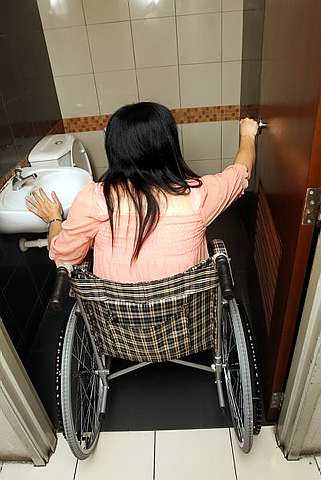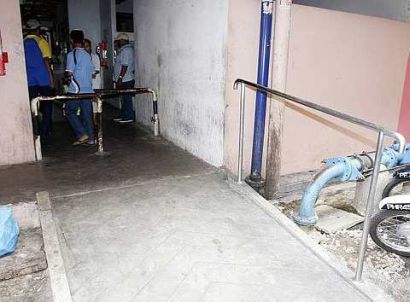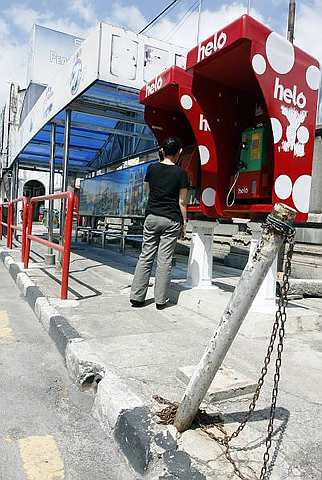The Star Metro
Home > Metro > CentralThursday March 12, 2009
KL folk happy with pedestrian boostMOST city residents see the pedestrian move as a moral boost and welcomed it with open arms.
“It’s definitely a great step forward as it will not only be convenient for the public to hop from one building to another but is’s also a great way to boost tourism,’’ Sungei Wang Plaza promotions and public relations manager K.K Lim said.
Lim added that Kuala Lumpur was still far behind Bangkok in terms of connectivity.
“The allocation will greatly help elevate the appeal of Bukit Bintang as a tourist hub,’’ said Joyce Yap, president of the Malaysian Association for Shopping and Highrise Complex Management.
Yap, who is also the acting Pavilion Kuala Lumpur CEO, said the project would improve accessibility and connectivity to the golden triangle and will indirectly encourage people to walk.
Bukit Bintang MP Fung Kui Lun said he welcomed the news as it would not only boost tourism but would connect the missing link between Bukit Bintang and the KLCC area.
“It’s great news and definitely good for business,’’ Ancasa Hotel & Spa, Kuala Lumpur public relations manager Melinda Ambrose said.
“We have been hearing about this project for years.
“In fact, there was talk recently that the Kuala Lumpur City Hall (DBKL) planned to build a RM20mil elevated walkway to connect the Menara Maybank, Ancasa Hotel, and the Cahaya Suria Shopping Centre with the Pudu Raya Bus Terminal and Chinatown,’’ Ambrose said.
Istana Hotel director of marketing and communications Hasma Ahmad also agreed that it was a good move.
Peter Tan, who has been using a wheelchair for more than two decades, however, hoped that the walkways and skybridges would be accessible for all.
“There has not been much improvement in facilities for the disabled and we hope that this would change,’’ Tan said.
City resident Shahjehan Safian also added that he was confident the move would help alleviate traffic congestion and also reduce the number of accidents.
Tag: built-environment
Malaysian Parliament Building Should Be MS 1184 Compliant
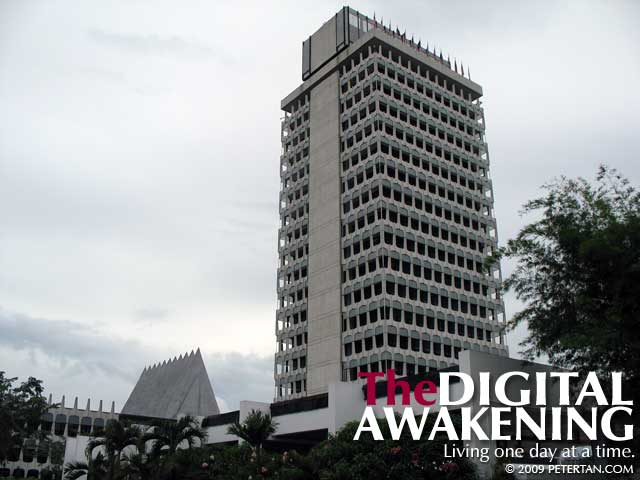
The Parliament Building Malaysia.
Dated December 20, 2006.
Photo by Wuan.
The Malaysian Parliament building is the symbol of democracy. It is there that bills are debated and laws passed to protect the wellbeing of the people. It also represents the people’s collective aspirations as a nation where the rights of each citizen is respected. From afar, its unique exterior is as magnificient as it is imposing. I have always been in awe of this impressive edifice.
Of all places, I had expected the Parliament building to be barrier free as we have the law and the code of practice to regulate such amenities. I was dead wrong. It was at the tower block of the Parliament that I came face to face with a steep ramp two years ago. That was the only access for wheelchair users into the building. Wheelchair users will find it hard to go up the ramp unassisted on that gradient. While watching the video of UMNO Youth confronting Karpal Singh outside the Parliament building, I caught a glimpse of Karpal being pushed up that same ramp.
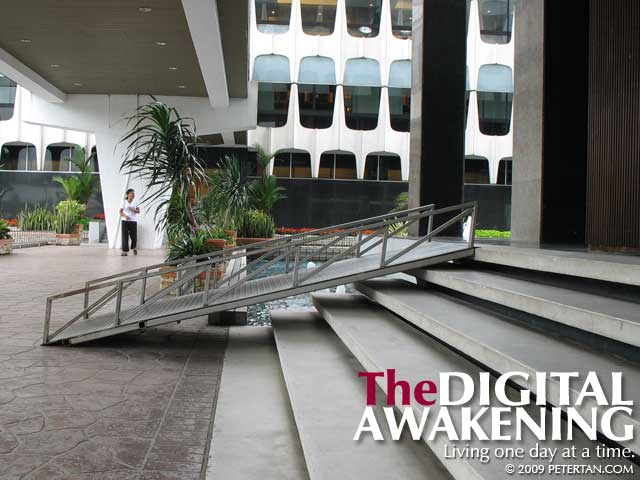
The steep ramp into the lift lobby of the tower block next to the Main Building of the Parliament.
Dated December 20, 2006.
Photo by Wuan.
There are a couple aspects of the ramp that are wrong. The ramp is too steep. It does not comply to the minimum 1:12 gradient as the specified in MS 1184: Code of Practice on Access for Disabled Persons to Public Buildings. The recommended height for the handrails on both side is between 840mm to 900mm. The Uniform Building By-law 34A (UBBL 34A) stipulates that all public buildings must comply to MS 1184. However, I was made aware that this by-law does not apply to government buildings. How ironic.
If the government is serious in making Malaysia accessible to disabled people, it should begin with the Parliament building. The existing ramp should be replaced with one that is in compliance with MS 1184. Parliament should take the lead in this matter. Otherwise, it is hypocritical to enforce the UBBL 34A when the very building where laws of the nation are made fall short of the accessibility standards required of others.
Plight of the disabled: The Star, Metro North – February 14, 2009
Saturday February 14, 2009
Plight of the disabled
By LOOI SUE-CHERNTOILETS for the disabled are often too small or are locked.
These are some of the problems faced by the disabled at some places in Penang, said Society of Disabled Persons (Penang) former president Tan Kuan Aw.
Tan, who is wheelchair-bound, said there were also toilets for the disabled which had been turned into storerooms because the managements of buildings where these toilets are located think not many people use them.
He said there were specifications that must be complied with when facilities for the disabled are provided such as handrails for ramps.
But after studying the situation in Penang for a decade, Tan did not think the local authorities were serious when it came to ensuring that these specfications were adhered to.
“The setting up of a barrier-free facility like a toilet for people with disabilities just for the sake of it is a misunderstood concept. There are Sirim standards and requirements that need to be followed,” he said in an interview.
A check by The Star in public places around Penang proved Tan’s descriptions of several public toilets accurate.
One such toilet in a building along the Jelutong Expressway was so small that a disabled person in a wheelchair would find great difficulty to close the toilet door from the inside.
Tight space: A woman in wheelchair demonstrating how difficult it is to use the cramped toilet for disabled persons.The reason for this, apart from the size of the toilet, is that the toilet door opens the wrong way. It opens inward, instead of outward or sliding.
Another toilet for the disabled persons in a shopping mall is occasionally locked and those who want to use the facility must find the cleaner who has the key, as instructed by a sign stuck to the door.
As for ramps, Tan said some were built without handrails. But in the case of the ramp at the Taman Sri Pinang flats on River Road, it was crossbars that has become a barrier for the disabled.
Stumbling block: A ramp with handrails is provided at Taman Sri Pinang but disabled persons, especially those in wheelchairs, cannot proceed further with the locked crossbars blocking the building’s entrance.Although the ramp has handrails, it is not barrier-free as there are crossbars at the bottom to prevent motorcyclists from using the ramp.
Women’s Centre for Change (WCC) committee member Lim Kah Cheng, who is an ardent activist for people with special needs, said the bars could also be a hindrance during emergencies like fires.
She said ramps could be designed in a way that motorcyclists could not misuse them, adding that the Penang Municipal Council (MPPP) had agreed to look into the matter.
“Instead of a ramp, a winding path that motorcyclists will find difficult to manoeuvre their vehicles on can be considered. The council already has the design which is not costly to follow,” said Lim, who is also an MPPP councillor.
Her other complaints include the putting up of signboards, road signs, advertisement boards and other obstructing objects in the middle of pavements or walkways; and high pavements.
Lim said the trick would be to get things right the first time – constructing buildings and providing public facilities that were universal.
“If you build a ramp, build one that is for everybody. What is good for the disabled is good for everyone else,” she added.
Danger lurks: This bus stop at Jalan Dr Lim Chwee Leong is unsafe for disabled persons, especially for the visually impaired and those in wheelchairs.MPPP president Datuk Zainal Rahim Seman, when contacted, said the council would take serious note of the problems faced by the disabled with the existing facilites.
“Our officers will conduct checks on these facilities to see if they comply with the required standards. If developers do not comply with building requirements, we will not grant them the CFs,” he added.

